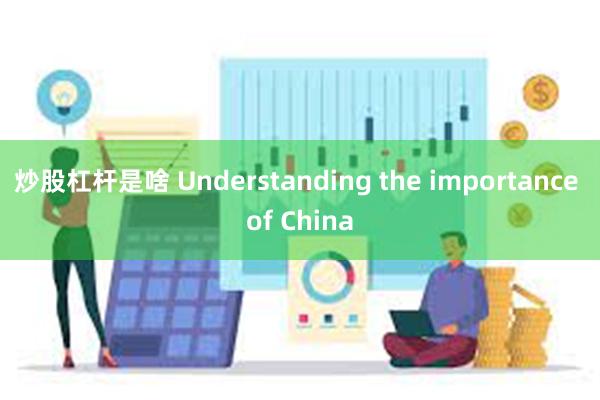你的位置:股票炒股配资网|配资炒股行情查询|股票配资导航查询网站 > 股票炒股配资网 > 炒股杠杆是啥 Understanding the importance of China
发布日期:2024-11-09 21:54 点击次数:80

御史杨维垣接连上书,弹劾同党兵部尚书崔呈秀,许多问题已涉及到魏忠贤,只不过他还不敢把矛头直接对着魏氏。朝中大臣更不断有人上书弹劾魏氏。工部主事陆澄源、兵部主事钱元懿、刑部员外郎史躬盛等都相继上书,矛头直指魏忠贤。浙江海盐贡生钱嘉徽在上书中明确列举了魏忠贤的十大罪状:并帝、蔑后、弄兵、无二祖列宗、克剥藩封、无圣、滥爵、邀边功、朘民脂膏、通同关节(《国榷》卷88),这十大罪状足以致魏忠贤于死地。朝臣的这些奏书,使崇桢对铲除魏氏势力增加了信心,他认为惩处魏氏的时机已到。于是,魏忠贤被召入,内侍向他宣读了朝臣的奏章,他听后十分恐惧。此刻,魏氏势力已大大削弱,为了保住自己岌岌可危的地位,魏忠贤重贿崇祯的太监徐应元。徐应元本是魏忠贤手下的太监,崇祯即位后渐受重用。魏忠贤使徐应元为他说项,想以辞去东厂印为代价,换回身家性命,然后再图谋东山再起。崇祯自然不会给他这种机会但为防止魏忠贤狗急跳墙,他同意魏忠贤交出东厂印、称疾辞官的请求。
他常呆在宅里读书抄习不出,过了月余,有邻家的女子取水于井上,年纪约十多岁。但令人奇怪的是这个女子取水常在井边一呆就是一两个小时,后来没过几天,此女子忽然就堕井淹死了。井中水深,打捞了一个晚上才捞上来。
This aerial photo taken on May 6, 2024 shows a construction site of the East Coast Rail Link (ECRL), a major infrastructure project under the Belt and Road Initiative (BRI) in Pahang, Malaysia. [Photo/Xinhua]
Malaysia's King Sultan Ibrahim Sultan Iskandar recently visited China, marking the first trip by a Malaysian king to China since 2014. The visit provided important moments that strengthened economic ties and high-level Belt and Road Initiative (BRI) collaboration.
It is clear that both China and Malaysia have made considerable gains in infrastructure cooperation, including plans to link Malaysia's multibillion dollar East Coast Rail Link (ECRL) with other China-backed railroad initiatives in Laos and Thailand. Ibrahim's visit reinforces optimism for a broader Pan-Asian railway network, affirming Beijing's readiness to propel regional connectivity by implementing the "Two Countries, Twin Parks" project and the flagship ECRL project.
With the Twin Parks project, Malaysia stands to reap notable benefits on the industrial and trade fronts. The signature BRI project has already helped set up major industrial parks in both Guangxi and Kuantan, providing an opportunity of growth for factories and industries spanning plastics, metals, electronics, consumer goods, renewables and a range of other products.
To leverage these industries and transform Kuantan into a buzzing trade hub, China and Malaysia need to work in tandem to facilitate mass commodity training and supply chain financing. Ibrahim's visit should be seen as an important step towards cultivating more foreign investments in these parks, and reaffirming the support of billions in new BRI cooperation agreements that were struck on the sidelines at the recent 21st China-ASEAN Expo in Nanning.
Similarly, expanding the ECRL could bring new transnational benefits to both sides. As a welcoming sign, the idea of expansion has already gained traction. Prospects of integrating Malaysia into railroad links from Kunming to Singapore were emphasized during Chinese Premier Li Qiang's visit to Malaysia in June. The potential benefits of the Pan-Asian railway network for Malaysia are immense, such as increased market access to China and accelerated trade of commodities. It also has the potential to situate Malaysia and China's future access routes within the broader regional market.
Without doubt, robust trade cooperation has also grown by leaps and bounds. For instance, China has served as Malaysia's top trading partner for nearly 15 years now. For Malaysian manufacturers, China continues to offer a sprawling consumer market that supports a surge in agricultural commodity exports. All this underlines the value of expanding trade links and promoting more competitive advantages between these two nations' economies.
Now that both partners have reaffirmed their commitment to a five-year economic and trade cooperation, ample incentives to deepen industrial links in high-end manufacturing and digital economy spheres have emerged. This merits significance because Malaysia is hoping to extract about 25% of its economic growth from the digital economy, underscoring robust commercial and innovative links with time-tested Chinese enterprises.
From a multilateral viewpoint, economic liberalization could evolve Sino-Malaysian economic cooperation in the future. After all, both countries share a principled stance on alternative payment settlements and balk at a multilateral trading system that is devoid of checks and balances. By opting for BRICS membership, Malaysia is better positioned to address pressing global economic issues through BRICS's established institutional mechanisms as well as stands to step up their sharing of technology with China. Similarly, shared priorities on regional economic integration could gain more impetus as Malaysia prepares for ASEAN's rotating chairmanship next year and vows to advance the China-ASEAN comprehensive strategic partnership.
The broader symbolism of Ibrahim's visit should not be overlooked. The Malaysian king hails from the southern state of Johor, which is the site of a mega Special Economic Zone (SEZ) that recently secured over $350 million in potential Chinese investments. Johor is also home to the China-backed Forest City Special Financial Zone (SFZ), an area that promises important economic incentives to accelerate state exports and facilitate Johor's broader socioeconomic development. Other areas of Malaysia are also boosting ties with China. For instance, Kuala Lumpur is cultivating favorable conditions for more Chinese enterprises, while Chinese investors continue to promote free and fair multisector investments.
These complementary approaches make it imperative to promote more high-level interactions between China and Malaysia that would bolster their five-year economic plan, covering a range of areas from high-tech manufacturing to the digital economy.
Ibrahim's recent visit should be seen as an important opportunity to reinforce joint priorities of connectivity and foster stronger ties between Chinese and Malaysian companies that are involved in key BRI projects. Diverse frontiers await China and Malaysia's relationship, with both sides standing to gain considerably from productive trade and connectivity prospects, multisector engagements, and joint investments.
The author is a foreign affairs commentator, author and recipient of the Fulbright Award.
Opinion articles reflect the views of their authors, not necessarily those of China.org.cn.
Follow China.org.cn on Twitterand Facebookto join the conversation.
ChinaNews App Download炒股杠杆是啥
astradeChinaandis发布于:北京市声明:该文观点仅代表作者本人,搜狐号系信息发布平台,搜狐仅提供信息存储空间服务。Powered by 股票炒股配资网|配资炒股行情查询|股票配资导航查询网站 @2013-2022 RSS地图 HTML地图